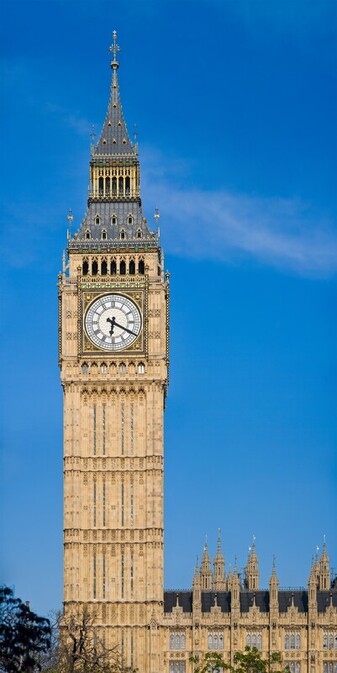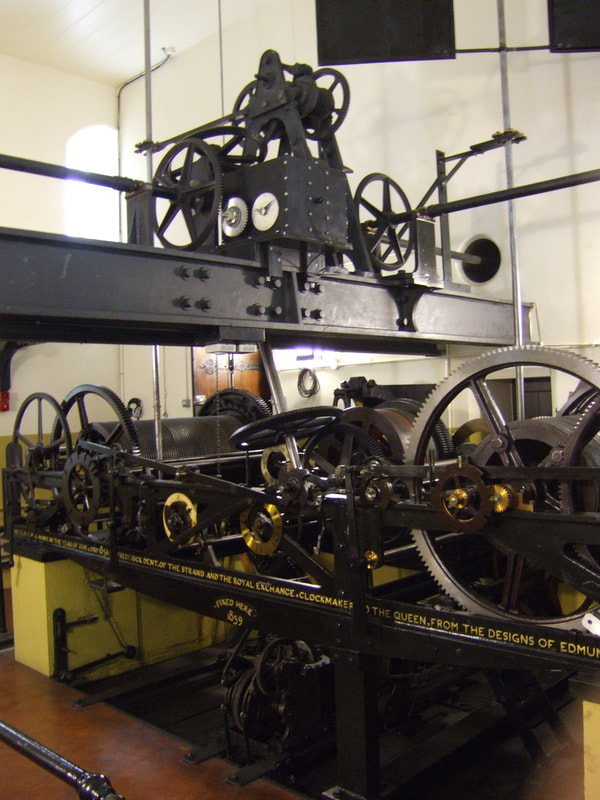|
The clock in the tower of the Palace of Westminster has been known as “Big Ben” for many years but the name was originally given to the largest of the tower’s five bells (the great hour bell) which weighs 13.7 tonnes, named after Benjamin Hall, who was in-charge of reconstructing the Westminster palace in the middle of the 19th Century.
Why was Edward Dent chosen to make the Clock movement of the Westminster Clock Tower? In the 1830's and 1840's, the Dent business was making watches and chronometers, as well as tower clocks. The Company had produced a number of tower clocks including one for the Royal Exchange in 1844 and one for the 1851 Exhibition which were accurate time-keepers. The Exhibition clock ran for 24 weeks and was only 3 seconds out at the end of that time. It was later moved to Kings Cross Station. A competition was held in 1846 to decide who should build the Clock movement for Big Ben. Sir George Airy, Astronomer Royal, was chosen to referree the competition and had specified that the clock should be accurate within one second when striking the hour. The Dent tender was eventually accepted in 1852 to make the clock for the tower of Westminster to the specification of Edmund Beckett Denison. The clock they produced has a large movement (See figure 2) with a flat-bed frame 15 feet six inches long and 4 feet 7 inches wide, a double three-legged gravity escapement and 13 feet long pendulum beating once every two seconds and weighing 700lbs
Edward J. Dent died in 1853, so his stepson Frederick took over the business and completed the clock in 1854 and tested it in the factory, but the clock was not set-up in the tower until the tower had been completed in 1859. The clock at Westminster has been described as the most famous clock in the world and the most accurate mechanical clock.
The inscription on the movement frame reads “ This clock was made in the year of our Lord 1854 by Frederick Dent of the Strand and Royal Exchange, clockmaker to the Queen, from the design of Edmund Beckett Denison, Q.C. Fixed here 1859”.
The life of Edward J. Dent
Edward John Dent was born on 19th August 1790, the son of John Dent and his wife Elizabeth and baptised on 18th October 1790 at St Clement Danes, Westminster. In 1804 Edward was apprenticed to his grandfather, John Wright Dent, as a tallow chandler (candlemaker). When he started his apprenticeship, he went to live with his widowed aunt Mary and her nephew Richard Rippon. Mary Dent had been married to a watchmaker David Calame and her sister Ann had married a blacksmith William Rippon, a freeman of the Blacksmiths’ Company (B.C). Ann and her husband William Rippon had a son Richard baptised at St Andrews Holborn 20th October 1766. When William and Ann Rippon decided to go to America about 1775, they left their son Richard with his aunt Mary and uncle David Calame who taught him watchmaking. When David Calame died Richard was able to take over the watchmaking business and continued to live over the shop with his aunt Mary at the “Seven Dials” in King Street. While watching his cousin Richard finishing repeating watches, Edward Dent was fascinated and decided he would like to become a clock and watchmaker. Having taught Edward about watchmaking Richard was able to find a fellow freeman of the B.C., Edward Gaudin in 1807 to complete Dent’s training as a clock and watchmaker from 13th Feb 1807 for the remainder of his 7 years (1807-1811, “Moore”). When his aunt Mary died, she left the watchmaking business and property to Richard, who then married Elizabeth Davis (she was 18, he was 40) on 9th July 1807 at St James, Paddington. The couple had four children, two boys and two girls. Edward Dent completed his apprenticeship in 1811 and returned to work for Richard Rippon as a journeyman 1811-1814, before setting up his own business as a watchmaker in 1814. After Richard Rippon died in 1824 Edward Dent taught Richard’s two son, William Frederick and Richard junior watchmaking, married their widowed mother, Elizabeth and adopted the children as his own sons and daughters. Edward J. Dent and his stepson William Frederick (both freemen of the B.C.) joined the Clockmakers’ Company together on the same day, the 7 Feb. 1831. Dent was in partnership with John Roger Arnold watchmaker and chronometer maker from 1830-1840. E. J. Dent wrote a book of “Lectures on the Construction and Management of Chronometers, Watches and Clocks” which was published in 1841. The Dent business built several tower clocks, including one for the Royal Exchange in 1844 and one for the 1851 Exhibition. He won the tender to build the Big Ben clock movement in 1852, but died in 1853, leaving his step son Frederick Dent to finish the clock.
Who was Augustus Pugin?
Augustus Pugin was born in 1812, the son of a French Draftsmen. Heis principally known for his role in the revival of Gothic Architecture. As well as writing several books, he designed 70 buildings, ranging from small parish churches to great country houses. His greatest achievement was designing the interior of Westminster Palace, as well as the Clock tower and clock dials of the palace. Pugin died on Sept. 14, 1852, in Ramsgate, Kent, and was buried there in the church of St. Augustine, which had been designed and at his own expense. Read more about the role of Edmund Beckett Denison in the production of the Westminster clock and its escapement. You can read more about Edward J. Dent, Richard Rippon in my latest book Early Clock and Watchmakers of the Blacksmiths' Company.
0 Comments
Leave a Reply. |
AuthorKeith Bates is an amateur horologist who has been researching clocks, watches and chronometers and their makers for over 30 years. Archives
August 2023
Categories
All
|



 RSS Feed
RSS Feed